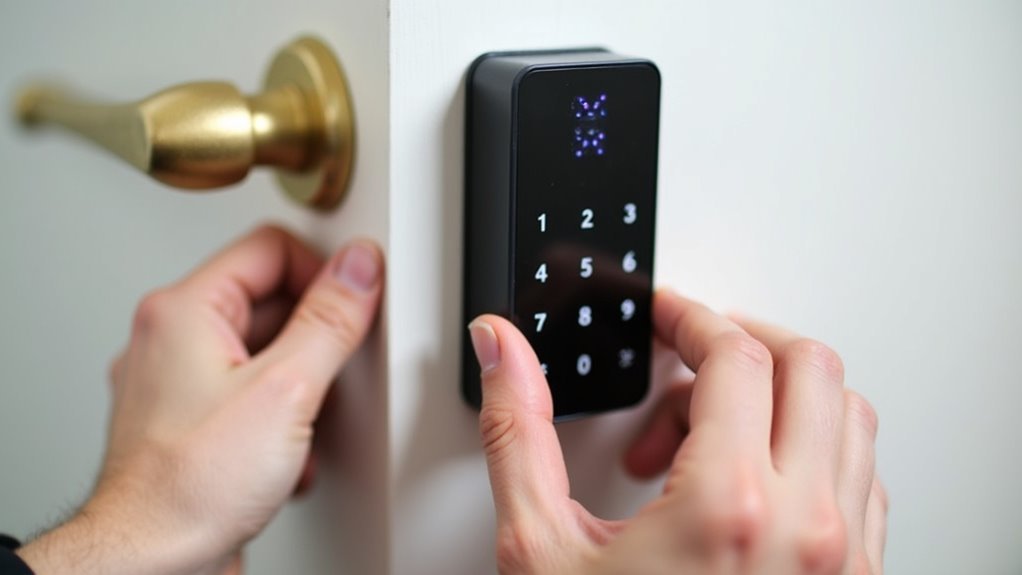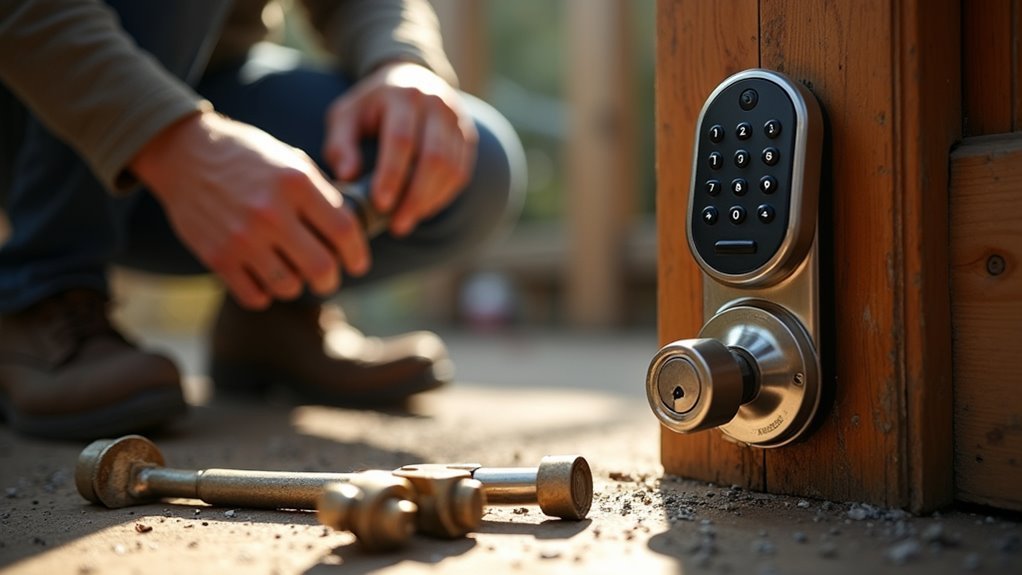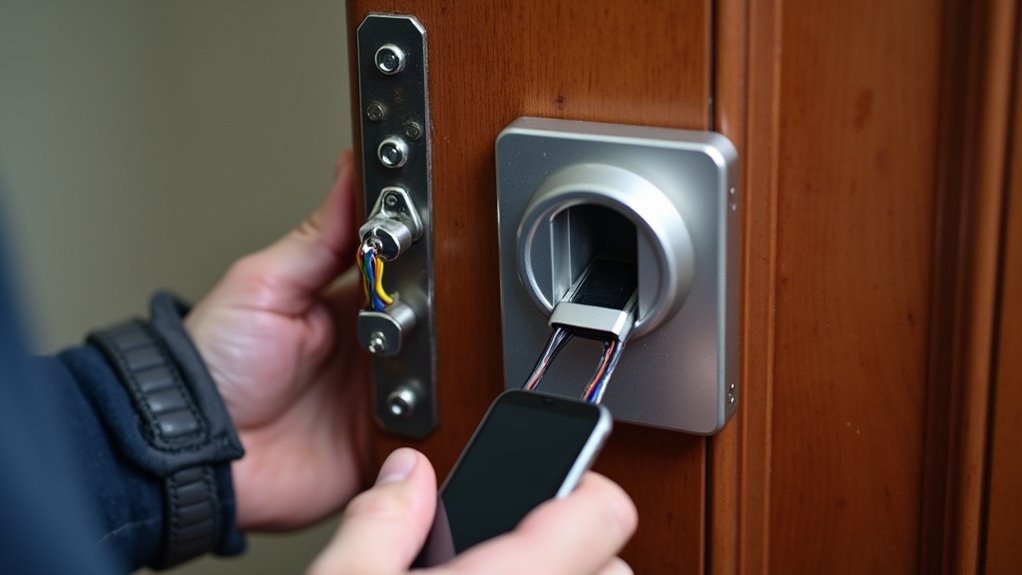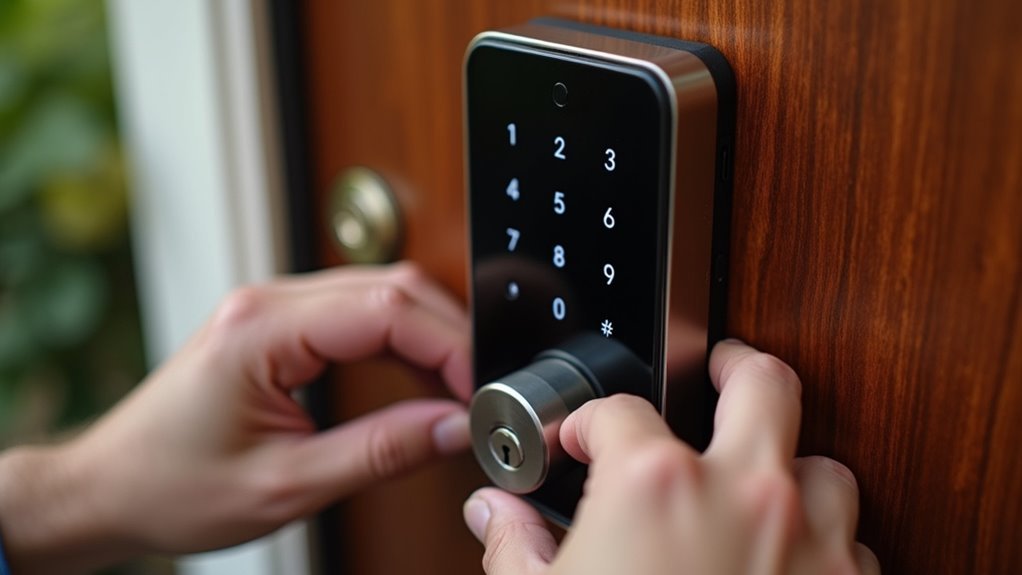You’ve probably fumbled for your keys in the dark or worried about lost copies falling into the wrong hands. Installing a keyless entry system eliminates these security vulnerabilities while offering unprecedented control over who accesses your home and when. Whether you’re considering a basic keypad lock or a sophisticated biometric scanner, the installation process requires careful planning and attention to detail. The choice you make now will impact your family’s safety for years to come.
What Is a Keyless Entry System for Your Home

Although traditional keys have secured homes for centuries, a keyless entry system revolutionizes how you access your property by eliminating the need for physical keys entirely.
These systems utilize keypads, smartphones, or biometric scanners to open your doors, providing enhanced security and convenience for your daily routine.
Keyless entry systems greatly reduce the risk of losing keys while offering temporary access codes for guests or service providers.
Smart locks often feature auto-locking mechanisms and tamper alerts, giving you greater peace of mind.
Many systems integrate seamlessly with smart home technology, enabling remote access and monitoring through smartphone apps.
Keyless entry installation typically costs between $500 to $2,500 per door, depending on the specific technology and hardware requirements you choose.
Benefits of Installing Keyless Entry Door Locks
When you install keyless entry door locks, you’ll immediately notice enhanced security features that protect your home better than traditional locks.
You can’t lose digital codes like physical keys, and many systems include auto-locking mechanisms and tamper alerts that actively defend against break-ins.
You’ll also gain convenient access control through temporary codes for guests and remote monitoring via smartphone apps.
Enhanced Security Features
Since physical keys can be lost, stolen, or copied without your knowledge, keyless entry door locks eliminate these vulnerabilities by removing the need for traditional keys altogether.
You’ll gain enhanced security through multiple protective layers that traditional locks simply can’t provide.
Modern keyless entry door lock systems offer advanced features that greatly enhance your home’s protection:
- Auto-locking and tamper alerts – Your door automatically secures itself and notifies you of any unauthorized access attempts
- Biometric recognition – Fingerprint scanning guarantees only registered users can enter your home
- Temporary access codes – You can create time-limited codes for guests without compromising long-term security
Remote management capabilities allow you to monitor detailed access logs, track entries and exits, and receive real-time notifications.
You’ll control your locks from anywhere using smartphone apps.
Convenient Access Control
Beyond strengthening your home’s defenses, keyless entry door locks transform how you access and manage your property on a daily basis.
Your smart lock eliminates fumbling for keys in the dark or rain, letting you enter with a simple code or smartphone tap. You’ll grant temporary access to guests, contractors, or cleaning services remotely without physical key exchanges.
The access control system automatically locks behind you, ensuring your secure home remains protected even when you forget. Through smartphone apps, you can monitor real-time activity logs showing exactly who entered and when.
This keyless door technology integrates seamlessly with existing smart home systems, creating a streamlined experience that puts complete property control at your fingertips.
Signs You Need to Upgrade to a Smart Lock System

You’ll know it’s time to upgrade when you’re constantly losing keys and paying for expensive replacements.
If your current locks show security vulnerabilities or can’t integrate with your smart home devices, you’re missing out on modern protection and convenience.
These clear indicators suggest your home would benefit from a keyless entry system that addresses these common frustrations.
Frequent Key Loss Issues
Constantly searching for misplaced keys signals it’s time to contemplate upgrading to a smart lock system. The frequent loss of keys creates security vulnerabilities and drains your wallet through costly replacements and locksmith fees.
Consider these compelling advantages of switching to a keyless entry system:
- Cost savings – You’ll eliminate the average $200 annual expense on key replacements and locksmith services.
- Enhanced security – Smart locks offer auto-locking features and tamper alerts, preventing lost keys from falling into wrong hands.
- Flexible access control – You can create temporary codes for guests and service providers without distributing physical keys.
A keyless entry system provides genuine peace of mind by eliminating the stress of misplaced keys and the hassle of rekeying locks, making it an intelligent investment for households prone to key mishaps.
Outdated Lock Security Vulnerabilities
When your lock cylinder sticks, turns with difficulty, or shows visible rust and corrosion, these physical deterioration signs indicate that your home’s first line of defense has weakened considerably.
Outdated locks displaying these symptoms become easy targets for break-ins, as damaged mechanisms offer minimal resistance to forced entry attempts. You’re fundamentally advertising vulnerability when visitors notice your lock’s deteriorated condition.
Traditional locks with worn components can’t provide the protection your family deserves.
A smart lock system eliminates these physical failure points through electronic mechanisms that don’t rust or wear down like metal cylinders.
You’ll gain enhanced security features including tamper alerts, auto-locking capabilities, and remote monitoring that outdated locks simply can’t offer, transforming your home’s access control from a liability into a sophisticated security advantage.
Smart Home Integration Desires
Beyond physical deterioration concerns, your growing collection of smart home devices signals another compelling reason to upgrade your lock system.
When you’ve invested in modern technology throughout your house, traditional locks create a frustrating gap in your connected ecosystem.
Smart locks integrate seamlessly with existing home automation platforms, allowing you to:
- Control access remotely through smartphone apps while monitoring entry activity
- Synchronize with security systems to automatically arm/disarm alarms when you arrive
- Connect with voice assistants for hands-free locking commands and status updates
If you’re already managing smart thermostats, lighting systems, or security cameras, you’ll appreciate how keyless entry completes your intelligent home setup.
The ability to install thorough access control that communicates with other devices transforms your entire security approach from reactive to proactive management.
Types of Keyless Entry Systems Available

As technology advances, you’ll find several distinct types of keyless entry systems designed to meet different security needs and preferences.
Keypad models require PIN codes for access, while smartphone apps enable remote access from anywhere. Biometric scanners offer enhanced security by reading your fingerprints for verification. RFID card systems provide convenient entry through simple card swipes, perfect for both residents and guests.
Smart locks integrate seamlessly with home automation platforms, delivering remote monitoring capabilities and detailed activity logs. You can also grant temporary access codes when needed.
Electronic locks offer installation flexibility since they’re available in both hardwired and battery-powered configurations. Most systems are designed for compatibility with existing security frameworks, ensuring smooth integration into your current setup while maintaining thorough protection.
Choosing the Right Keyless Entry System for Your Property
With numerous keyless entry options available, selecting the system that best fits your property requires careful evaluation of your specific requirements and constraints.
You’ll need to determine your access control preferences, whether you prefer keypad entry, smartphone connectivity, or biometric scanning.
Consider these essential factors when making your decision:
- Installation requirements – Some systems need professional setup while others you can install yourself
- Credential flexibility – Look for systems offering multiple access methods like PIN codes and mobile apps for residents and guests
- Integration capabilities – Confirm compatibility with existing property management software to streamline operations
Budget between $500 to $2,500 per door depending on your chosen technology and hardware.
Evaluate how much user management control you’ll need before finalizing your keyless entry system selection.
Tools and Materials Required for Installation
Before you begin installation, gathering the right tools and materials guarantees you’ll complete your keyless entry setup efficiently and safely.
You’ll need a keyless lock kit containing the lock, mounting hardware, and detailed instructions. Essential tools include Phillips and flathead screwdrivers, a drill with appropriate bits, tape measure, and pencil for marking positions.
A chisel helps make door adjustments, while a level guarantees proper alignment of lock components. Don’t forget safety glasses to protect your eyes from debris during installation.
If your keyless system requires hardwiring, keep a multimeter handy for checking power requirements. Having these tools ready prevents delays and guarantees professional results.
Preparing Your Door for Keyless Entry Installation
Before you can install your new keyless entry system, you’ll need to assess whether your door can accommodate the hardware and remove any existing locks.
Start by checking your door’s thickness, material, and current lock setup to verify compatibility with the new system’s requirements.
Once you’ve confirmed compatibility, completely remove the existing handle, deadbolt, and strike plates to clear the way for your keyless entry installation.
Door Compatibility Assessment
Success with keyless entry installation hinges on choosing a system that’s perfectly matched to your door’s specifications.
Before you purchase any keyless lock, you’ll need to conduct a thorough door compatibility assessment to avoid installation headaches.
Start by measuring your door’s thickness, as most keyless systems accommodate doors between 1.375 to 2 inches.
Next, measure the backset from your existing lock – typically 2.375 or 2.75 inches from the door’s edge to the lock center.
Consider these critical factors:
- Door material strength – wood, fiberglass, and metal each require different installation approaches
- Frame alignment – check for gaps or misalignment that could affect operation
- Deadbolt compatibility – verify your current mechanism works properly
These measurements determine which keyless systems will work effectively with your door.
Existing Lock Removal
Once you’ve confirmed your door’s compatibility with your chosen keyless system, you’ll need to remove the existing hardware to make way for the new installation. Start by gathering your essential tools: screwdriver, drill, and measuring tape. Begin unscrewing all existing door hardware, including handles, deadbolts, and strike plates to access the lock mechanism completely.
| Step | Action | Tools Needed |
|---|---|---|
| 1 | Remove handle and deadbolt | Screwdriver |
| 2 | Unscrew strike plates | Screwdriver |
| 3 | Extract lock mechanism | Drill (if needed) |
| 4 | Clean door surface | Measuring tape |
Carefully extract the old lock from the door, noting any wiring or special components. Inspect the door thoroughly for compatibility issues, then clean and measure the surface to guarantee your new keyless entry system will install securely.
Step-by-Step Installation Process for Smart Locks
Installing a smart lock requires five essential tools to confirm the process runs smoothly and safely.
Five essential tools ensure your smart lock installation proceeds safely and efficiently from start to finish.
You’ll need a screwdriver, drill, measuring tape, level, and safety glasses before beginning the installation process. After removing your existing lock, measure and mark new hole positions carefully.
Next, install keyless deadbolt mechanism into the door’s edge, making sure it fits snugly. Then attach the exterior assembly with proper keypad alignment.
The final steps involve:
- Connecting interior assembly and cables per manufacturer’s instructions
- Securing all components tightly to prevent loosening
- Testing default access codes and scanner functionality
You’ll want to verify your locks operate smoothly before programming unique user codes.
This systematic approach will guarantee a smooth shift to your new keyless entry system.
Programming and Configuring Your New System
Three critical steps will transform your newly installed smart lock into a fully functional keyless entry system.
Begin programming by following manufacturer instructions to enter the default code and access programming mode. You’ll typically create multiple access codes for family members and temporary codes for guests, giving you complete control over home entry.
Next, connect your system to its smartphone app through Bluetooth or Wi-Fi pairing. This connection enables remote monitoring and enhanced security features from your mobile device.
Finally, test the lock thoroughly to verify all programmed codes work correctly and the mechanism engages smoothly. Confirm both manual and app-controlled operations function properly.
Remember to regularly update your access codes and app settings to maintain peak security and control over who accesses your home.
Testing Your Keyless Entry System for Proper Function
After you’ve programmed your keyless entry system, you’ll need to verify it’s working correctly through thorough testing.
Start with initial functionality tests to confirm all components respond properly, then establish a routine for ongoing performance monitoring.
These testing phases guarantee your system maintains reliable operation and helps you catch potential issues before they become security problems.
Initial System Functionality Tests
Once you’ve completed the installation process, you’ll need to verify that your keyless entry system operates correctly through thorough testing. These initial system functionality tests guarantee your investment provides reliable security and convenience.
Start by testing the default access code or biometric scanner to open your door smoothly. Watch the deadbolt carefully—it should extend and retract fully without resistance, confirming proper alignment and mechanical function.
Next, focus on these critical verification steps:
- Program and test your unique primary access code for consistent performance
- Connect and test smartphone app features for remote access capabilities
- Verify all locking mechanisms operate without hindrances or delays
Remember to monitor access regularly and perform functionality tests after any system updates or changes to maintain peak performance and security.
Ongoing Performance Monitoring
Address *connectivity issues* promptly when your keypad becomes unresponsive or the biometric scanner malfunctions.
Verify your Wi-Fi or Bluetooth connections remain active and check for available firmware updates.
Test your default access codes and biometric features monthly, operating the deadbolt multiple times to confirm smooth extension and retraction.
This proactive approach prevents security vulnerabilities.
Setting Up User Access and Management Features
When you’re configuring user access for your keyless entry system, you’ll need to create unique PIN codes or digital keys for each person who requires entry. This approach allows you to establish customizable access levels and maintain easy management control over your security system.
Your management software provides a web-based dashboard where you can remotely handle all user credentials. From any device, you’ll be able to add, revoke, or modify access permissions quickly and efficiently.
Remote management capabilities allow property managers to control access permissions instantly from any location using an intuitive web-based interface.
Key management features include:
- Temporary access codes for visitors or service personnel with specific timeframe restrictions
- Regular credential updates when tenants move or personnel changes occur
- Access log monitoring to track entry times and identify unauthorized attempts
You can monitor access logs through the software to maintain your system’s security integrity.
Maintaining Your Keyless Entry Door Lock
While your keyless entry system offers superior convenience and security compared to traditional locks, it requires consistent maintenance to perform at its finest.
Start by maintaining ideal battery life through regular replacements every 6 to 12 months, preventing unexpected lockouts. Clean the keypad and internal components using a soft, damp cloth to remove dirt that interferes with sensors and mechanisms.
Inspect your lock periodically for wear signs like loose screws or misalignments, addressing issues immediately to preserve security. Keep app-connected locks updated with the latest software for enhanced security features.
Conduct routine functionality tests, verifying that auto-lock features and access codes work correctly. This proactive approach guarantees your keyless entry system continues providing reliable, secure access to your home for years to come.
Troubleshooting Common Installation Issues
Even with careful planning, installation hiccups can frustrate homeowners keen to enjoy their new keyless entry system. When your deadbolt won’t align with the strike plate, you’ll need to adjust both components during installation for smooth operation.
Common troubleshooting steps include:
- Check battery levels – Unresponsive keypads or fingerprint scanners often indicate low battery power that prevents proper functionality.
- Verify connectivity settings – Ascertain your smartphone’s Bluetooth or Wi-Fi is enabled and the smart lock stays within network range during pairing.
- Inspect for obstructions – Deadbolts that won’t extend or retract typically suffer from installation misalignment or hardware blockages.
If problems persist after these troubleshooting attempts, consult your manufacturer’s guide or contact customer support for system-specific solutions.
Cost Analysis and Long-Term Value of Keyless Entry Systems
Beyond the initial appeal of cutting-edge security, you’ll want to evaluate whether keyless entry systems deliver genuine financial value for your home investment.
Your cost analysis should consider installation expenses ranging from $500 to $2,500 per door, depending on system complexity and property layout. However, keyless entry systems provide substantial long-term value through reduced operating costs and enhanced secure access management.
| Cost Factor | Traditional Locks | Keyless Entry Systems |
|---|---|---|
| Installation | $100-300 | $500-2,500 |
| Rekeying | $75-200 per event | $0 (remote management) |
| Key replacement | $5-50 each | Not applicable |
| Future integration | Limited | Smart home compatible |
You’ll eliminate expenses for physical key management while gaining remote monitoring capabilities. Regular maintenance, including software updates and battery replacements, guarantees continued effectiveness and protects your investment’s longevity.
Frequently Asked Questions
How Much Does It Cost to Install Keyless Entry?
You’ll spend $500 to $2,500 per door for keyless entry installation. Your costs depend on system complexity, property layout, and whether you’re replacing existing locks or need electrical wiring for power.
Can Keyless Entry Be Installed?
Yes, you can install keyless entry systems yourself for simpler models using basic tools, or hire professionals for complex installations. You’ll need to assess door compatibility and follow manufacturer instructions carefully.
Can I Convert My Car to Keyless Entry?
You can convert your car to keyless entry using aftermarket conversion kits costing $100-300. These systems require basic wiring skills or professional installation and often include features like remote start and alarm integration.
Can a Locksmith Install a Keyless Entry?
Yes, you can hire a locksmith to install keyless entry systems. They’ll guarantee proper alignment, functionality, and security while handling smart locks and biometric technologies with professional expertise and certification.





Leave a Reply